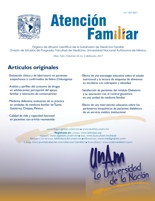Clinical and Laboratory Evaluation in Patients with a Suspected or Confirmed Diagnosis of Chikungunya Fever
Main Article Content
Abstract
Objective: to evaluate the clinical and laboratory relation in patients with suspected or confirmed diagnosis cases of Chikungunya fever. Methods: cross-sectional and descriptive study with patients from the outpatient consultation of the Family Medicine Unit no. 11, of the Mexican of the Social Security Institute (imss), in Tapachula, Chiapas, Mexico. Patients who presented a suspected or confirmed diagnose of Chikungunya during the months of January to October 2015 were analyzed and the relationship between symptoms and laboratory parameters were evaluated. Results: a total of 243 patients were identified, 94 (39%) male and 149 (61%) female, confirmation of Chikungunya was confirmed in nine patients using the rt-pcr technique. The t of Student test signs/symptoms and laboratory parameters (leukopenia, neutropenia and lymphopenia) with a value of p<0.000 was used. For the analysis of linear relationship between quantitative variables, the Pearson correlation of fever- polyarthralgias was used low positive correlation (0.031), with an arthritis result in negative correlation (-0.210), regarding neutropenia-fever positive correlation (0.295) and polyarthralgias-arthritis low positive correlation (of 0.10 to 0.20). Conclusions: Chikungunya fever in acute phase denotes clear symptomatology and signs, so the diagnosis is clinical, however, it must be supported by blood cytometry that provides a differential assessment in relation to other vector-borne diseases.
Downloads
Download data is not yet available.
Article Details
How to Cite
Ochoa Tapia, E., Hernández Hernández, A., Gordillo Martínez, M. M., & Palacios Stempreiss, A. (2017). Clinical and Laboratory Evaluation in Patients with a Suspected or Confirmed Diagnosis of Chikungunya Fever. Atención Familiar, 24(2). https://doi.org/10.22201/facmed.14058871p.2017.2.59150
